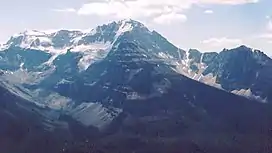| Ball Range | |
|---|---|
 | |
| Highest point | |
| Peak | Mount Ball |
| Elevation | 3,311 m (10,863 ft)[1] |
| Listing | |
| Coordinates | 51°09′23″N 116°00′23″W / 51.15639°N 116.00639°W[2] |
| Dimensions | |
| Length | 26 km (16 mi) W-E[3] |
| Width | 35 km (22 mi) N-S[3] |
| Geography | |
 | |
| Country | Canada |
| Province | British Columbia |
| Range coordinates | 51°09′02″N 115°59′21″W / 51.15056°N 115.98917°W[4] |
| Parent range | Canadian Rockies |
| Topo map | NTS 104O6 Tahoots Creek |
The Ball Range is a mountain range on the Continental Divide between Vermilion Pass and Red Earth Pass in Kootenay National Park, Canada.[5] The range is named after John Ball,[6] a politician who helped secure funding for the Palliser expedition.
It extends over 465 km2 (180 sq mi), and measures 35 km (22 mi) from North to South and 26 km (16 mi) from East to West.[3]
Peaks
This range includes the following mountains and peaks:
| Mountain/Peak | Elevation (m/ft) | |
|---|---|---|
| Mount Ball | 3,311 | 10,863 |
| Stanley Peak | 3,155 | 10,351 |
| Beatrice Peak | 3,125 | 10,253 |
| Storm Mountain | 3,158 | 10,361 |
| Isabelle Peak | 2,926 | 9,600 |
| Haiduk Peak | 2,920 | 9,580 |
| Scarab Peak | 2,918 | 9,573 |
| The Monarch | 2,895 | 9,498 |
| Mount Shanks | 2,838 | 9,311 |
| Copper Mountain | 2,795 | 9,170 |
References
- ↑ Kane, Alan (1999). "Mount Ball". Scrambles in the Canadian Rockies. Calgary: Rocky Mountain Books. pp. 216–217. ISBN 0-921102-67-4.
- ↑ "Mount Ball". Bivouac.com. Retrieved 2019-06-11.
- 1 2 3 "Ball Range". Peakbagger.com. Retrieved 2019-06-11.
- ↑ "Ball Range". Geographical Names Data Base. Natural Resources Canada. Retrieved 2019-06-11.
- ↑ "Ball Range". cdnrockiesdatabases.ca. Retrieved 2019-06-11.
- ↑ "Ball Range". BC Geographical Names. Retrieved 2019-06-11.
This article is issued from Wikipedia. The text is licensed under Creative Commons - Attribution - Sharealike. Additional terms may apply for the media files.